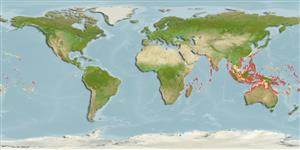>
Eupercaria/misc (Various families in series Eupercaria) >
Labridae (Wrasses) > Cheilininae
Etymology: Cirrhilabrus: Latin, cirrus = curl fringe + Greek, labros = furious (Ref. 45335).
More on author: Smith.
Environment: milieu / climate zone / Tiefenbereich / distribution range
Ökologie
seewasser riff-verbunden; tiefenbereich 6 - 40 m (Ref. 48636), usually ? - 10 m (Ref. 5278). Tropical; 33°N - 24°S
Indo-Pacific: East Africa south to Sodwana Bay, South Africa (Ref. 4392) and east to the Tuamoto Islands.
Size / Gewicht / Alter
Geschlechtsreife: Lm ? range ? - ? cm
Max length : 12.0 cm SL Männchen/unbestimmt; (Ref. 9823)
Rückenflossenstacheln (insgesamt) : 11; Rückenflossenweichstrahlen (insgesamt) : 8 - 9; Afterflossenstacheln: 3; Afterflossenweichstrahlen: 9. Large oval black spot on caudal peduncle just above lateral line (Ref. 4392). A closely related undescribed species occurs in west and central Pacific; differs in color, greatest between nuptial males (Ref. 48636).
Body shape (shape guide): fusiform / normal; Cross section: compressed.
Occurs over rubble or low patch reefs in areas of current (Ref. 9823); also on reef edges and around bommies with rubble zones (Ref. 48636); often in moderately large groups and mixed sex during feeding on zooplankton well above the substrate. Males often display to each other (Ref. 48636). Reported to be associated with the mushroom coral Heliofungia actiniformis (Ref. 91291). Feeds on zooplankton in the water column (Ref. 9823).
Life cycle and mating behavior
Geschlechtsreife | Fortpflanzung | Ablaichen | Eier | Fecundity | Larven
Distinct pairing during breeding (Ref. 205).
Randall, J.E., 1992. A review of the labrid fishes of the genus Cirrhilabrus from Japan, Taiwan and the Mariana Islands, with descriptions of two new species. Micronesica 25(1):99-121. (Ref. 5278)
IUCN Rote Liste Status (Ref. 130435: Version 2025-1)
Bedrohung für Menschen
Harmless
Nutzung durch Menschen
Fischereien: kommerziell; Aquarium: Kommerziell
Tools
Zusatzinformationen
Download XML
Internet Quellen
Estimates based on models
Preferred temperature (Ref.
123201): 26.3 - 29.3, mean 28.5 °C (based on 2345 cells).
Phylogenetic diversity index (Ref.
82804): PD
50 = 0.5000 [Uniqueness, from 0.5 = low to 2.0 = high].
Bayesian length-weight: a=0.01585 (0.00700 - 0.03587), b=2.95 (2.76 - 3.14), in cm total length, based on LWR estimates for this (Sub)family-body shape (Ref.
93245).
Trophic level (Ref.
69278): 3.4 ±0.45 se; based on food items.
Widerstandsfähigkeit (Ref.
120179): hoch, Verdopplung der Population dauert weniger als 15 Monate. (Preliminary K or Fecundity.).
Fishing Vulnerability (Ref.
59153): Low vulnerability (10 of 100).
🛈
Nutrients (Ref.
124155): Calcium = 99.2 [57.4, 186.1] mg/100g; Iron = 0.867 [0.498, 1.658] mg/100g; Protein = 18.2 [15.3, 20.4] %; Omega3 = 0.162 [0.095, 0.273] g/100g; Selenium = 22.6 [12.7, 44.7] μg/100g; VitaminA = 256 [76, 929] μg/100g; Zinc = 1.75 [1.17, 2.77] mg/100g (wet weight);
